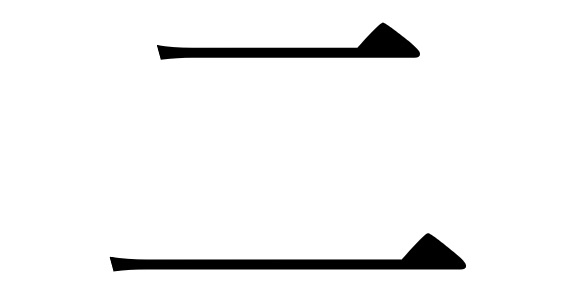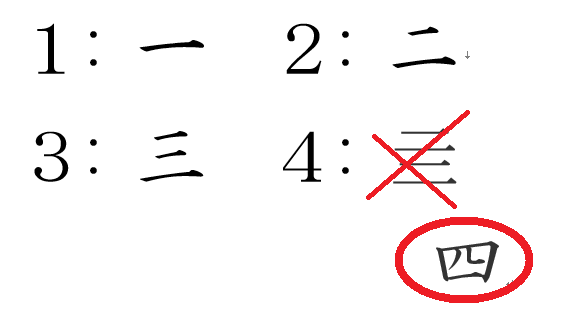One of the most intimidating things about learning Japanese is the writing system. There are three different sets of characters you’ll need to become proficient in, and while two of them, hiragana and katakana, aren’t too difficult to master, kanji, the set originally imported from China, is a high hurdle.
Japan’s Ministry of Education has designated 2,136 characters as “general-use kanji,” and while you may not need to know each and every one to function in Japanese society, you’ll need a firm mental grip on several hundred if you really want to integrate yourself into the cultural or professional spheres. With so many to learn, most structured courses, and self-studiers as well, start with the easiest kanji, ichi, which means one.

While you could possibly interpret a horizontal line in a few different ways, it’s not too hard to wrap your head around the fact that in Japan, a single sideways stroke represents the concept, and thus the word for, “one.” After inputting that in their brains, most learners will turn the page of their textbook and find the kanji for ni, or “two.”

This seems like a pretty logical progression, right? One horizontal line means one, two horizontal lines means two. The next on the kanji study list is generally san, or “three,” and you can probably guess where this is going.

Wow, if all kanji are this straightforward, you’ll have those 2,136 general-use ones memorized in no time, right? Okay, let’s move on to yon, or “four,” although at this point it seems like just a formality, since in keeping with the established pattern it’ll probably be...

But try writing that on your kanji test, and your teacher is likely to strain a forehead muscle from cocking an eyebrow harder than he would if you referred to yourself with the macho pronoun ore when speaking in class. However, history would be on your side, even if your instructor probably wouldn’t, since long, long ago the kanji 亖 actually was an acceptable way of writing “four.”
However, 亖 never shows up in contemporary usage, and it takes a fair bit of wrangling to even get it to appear when typing in Japanese (it’s literally easier to summon a dragon with a Japanese word processor than to produce the kanji 亖). So how did it get replaced, and why?

Let’s start with the “how” part of that question. As mentioned above, while Japan has developed some kanji of its own over the years, the writing system originally came from China. There, too, 亖 was once an acceptable way of writing “four.” However, somewhere along the line, people started using the kanji 四 to represent “four” as well.
四 seems like a strange choice at first. Originally, it meant “breath” and was meant to be a visual representation of teeth or a tongue inside a mouth (“mouth” by itself being written with the kanji 口). However, the Chinese pronunciations of 四 and 亖 were identical, and so some people started using 四 to represent “four.” Eventually, 四 became the preferred rendering for “four,” which then prompted the development of a new kanji for “breath,” 息 (a compound of the kanji for “self,” 自, and “heart,” 心).
But what turned popular opinion, and eventually society as a whole, against 亖? There was no official changeover decree, owing to language’s nature as a gradually and constantly evolving thing. However, the common-sense explanation is that while 一, 二, and 三 are all pretty easy to identify with a momentary glance, 亖 had moved beyond, or at least approached, the tipping point where the eye and mind can instantaneously process the information without requiring conscious counting.
From a practical standpoint, a line had to be drawn somewhere in stacking horizontal lines increasingly higher. After all, while the meaning of 八, the kanji for “eight,” may not be intrinsically understandable, it saves people from having to squint at small-font text to see if there are eight or nine strokes crammed together in a small vertical space. Others have pointed out that this concept that four repeating visual elements is too many appears in Roman numerals as well, which capped it’s vertical lines at three after Ⅰ, Ⅱ, and Ⅲ and then started mixing things up with Ⅳ.
So once again, yes, Japanese can be a difficult language to learn, sometimes frustratingly so. However, there’s often a reason for things being done the way they are.
Sources: IT Media, Okijiten
Read more stories from SoraNews24.
-- Foreigners in Japan vote for the best-looking katakana character
-- Kanji fail — Japanese parents shocked to learn their baby girl’s name has inappropriate meaning
-- “Gold” named 2016 Kanji of the Year
- External Link
- http://en.rocketnews24.com/2017/06/15/why-is-the-japanese-kanji-for-four-so-frustratingly-weird/?iframe=true&preview=true
 Take our user survey and make your voice heard.
Take our user survey and make your voice heard.















16 Comments
Login to comment
kibousha
Article without proper research
http://vividict.com/WordInfo.aspx?id=3602
It started with 亖, basically 4 is 二 twice. The character then became four horizontal line of equal length, then it became IIII, later they added 二, then it becomes like the horizontal version of 目, then the current 四. It didn't go from 亖 directly to 四.
Aly Rustom
How about adopting the arabic numerals instead of the chinese symbols? There, solved the dilemma for you.
lucabrasi
And in Roman numerals, "4" can be
"IIII" (especially on clocks), or "IV".
Strangerland
Really? I've never seen that.
As an addition to the article, 1 is usually written as 一, however it can also be written as 壱. It was explained to me that someone can add an extra line to make a 1 into a 2 or even a 3, so money/numbers can be easily 'hacked'. By using the 壱 kanji for 1, this cannot be done.
lucabrasi
@Strangerland
Yep. And 2 and 3 can be 弐 and 参 for the same reason.
Take a good look next time you see Roman numeral clock-face for IIII.
Dan Lewis
This frustrates the author!? Poor guy. Life must be really hard! Why not just accept what it is and leave it at that? It's not difficult.
smithinjapan
Not that frustrating unless you over think it. Far more frustrating to listen to someone pull his or her hair out about something that just is. Remember it, and move on.
A better question, and a more difficult thing to remember when using large numbers, is why Japan adopted the 3-digit counting system for writing but still say numbers in four digit groups (ex. writing "1,000,000" but saying "100-man"). In any case, another thing you should just try and remember for the time being, and move on.
roughneck
Please stop judging how other culture uses their language that doesn't fit your "logic".
M3M3M3
Sometimes it's good to judge other cultures to see what is good or bad, efficient or inefficient in your own culture. If you think all cultures are equal and whatever system they happen to use at this moment will always be the best way of doing things for them, nothing will ever improve or change. I'm glad western society dropped Roman numerals and adopted the zero. It's almost impossible to do advanced arithmetic any other way. Other cultures have dropped logograms and adopted an alphabet because they thought it was better.
gogogo
WHY JAPAN WHY!
roughneck
Why? We are not complaining about our culture! All cultures are obviously not equal. Some are really nosy about other's cultures.
M3M3M3
Well, I have no idea what the point of this particular article is, but I'm just pointing out that it's human nature to look at what other humans are doing and pass judgement on them. We've been doing it for hundreds of thousands of years. Unless we do this, we will never know whether there is anything within our own culture to complain about. Perhaps the unspoken point of this article is just to remind us that our number 4 is pretty decent. I don't remember any episodes of Sesame Street ever being brought to us by 四, 亖, IV, or IIII.
ThonTaddeo
The European digits 2 and 3 also come from horizontal lines, connected together (as do Arabic ٢ and ٣ with vertical lines), but are less transparent than 二 and 三. Maybe the West should adopt 二 and 三 before complaining about 四.
Stefan Peters
You rarely see the kanji for the numbers anyway, so I don't see why this would bother anyone. The only times that I've seen the kanji numerals in Japan (as far as I remember) was for the prices in some restaurants (and even then they use 七八〇 for 780 instead of 七百八十).
tinawatanabe
over the centuries or millenniums. The majority of Kanji Chinese use is imported from Japan.
mukashiyokatta
It is neither weird nor frustrating. Next!